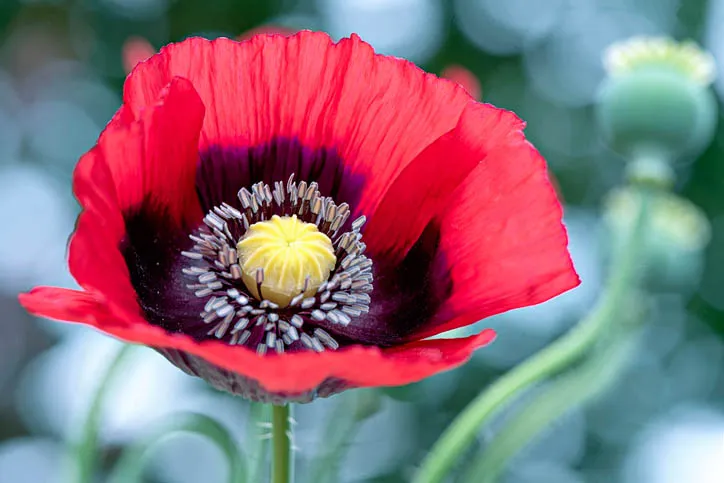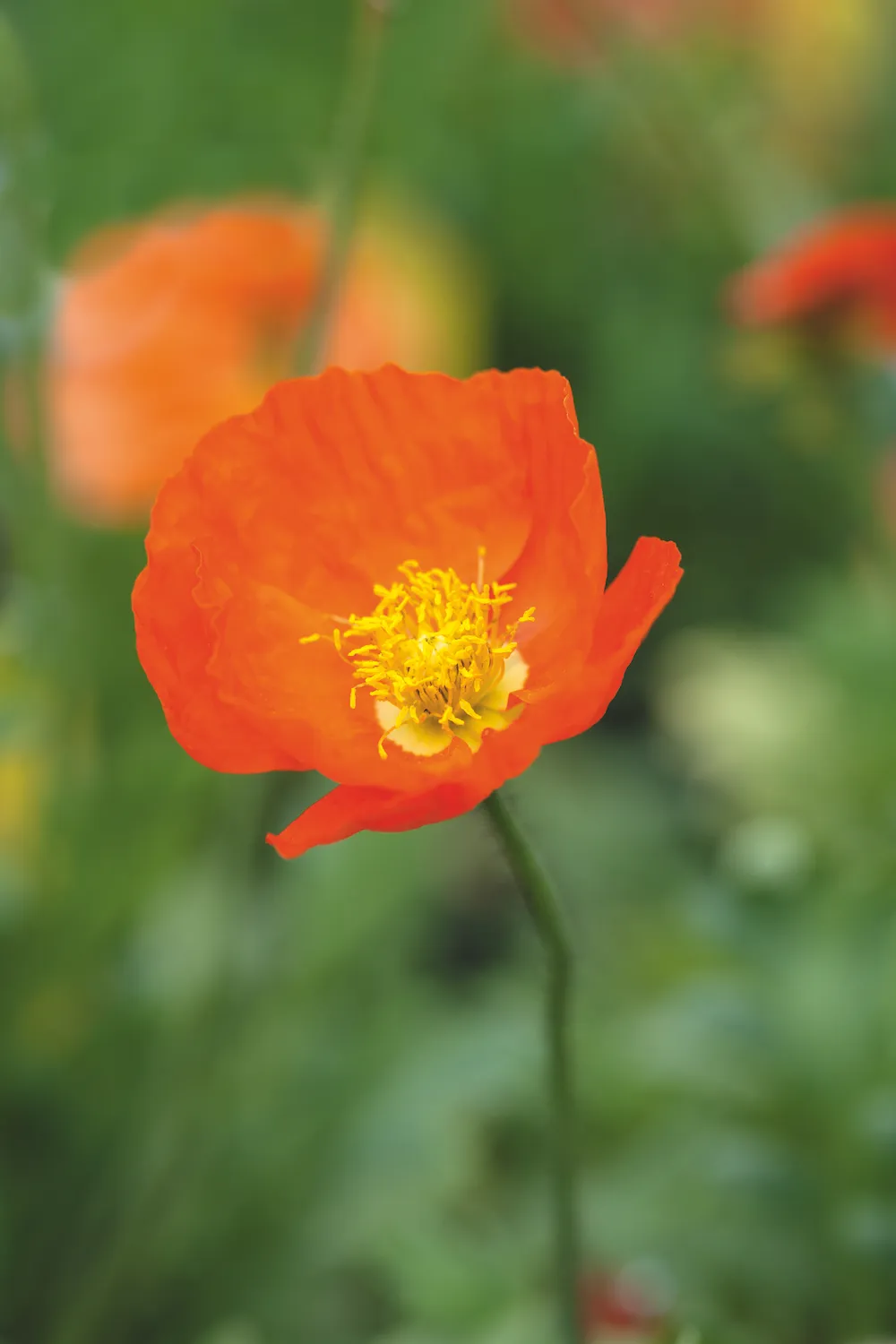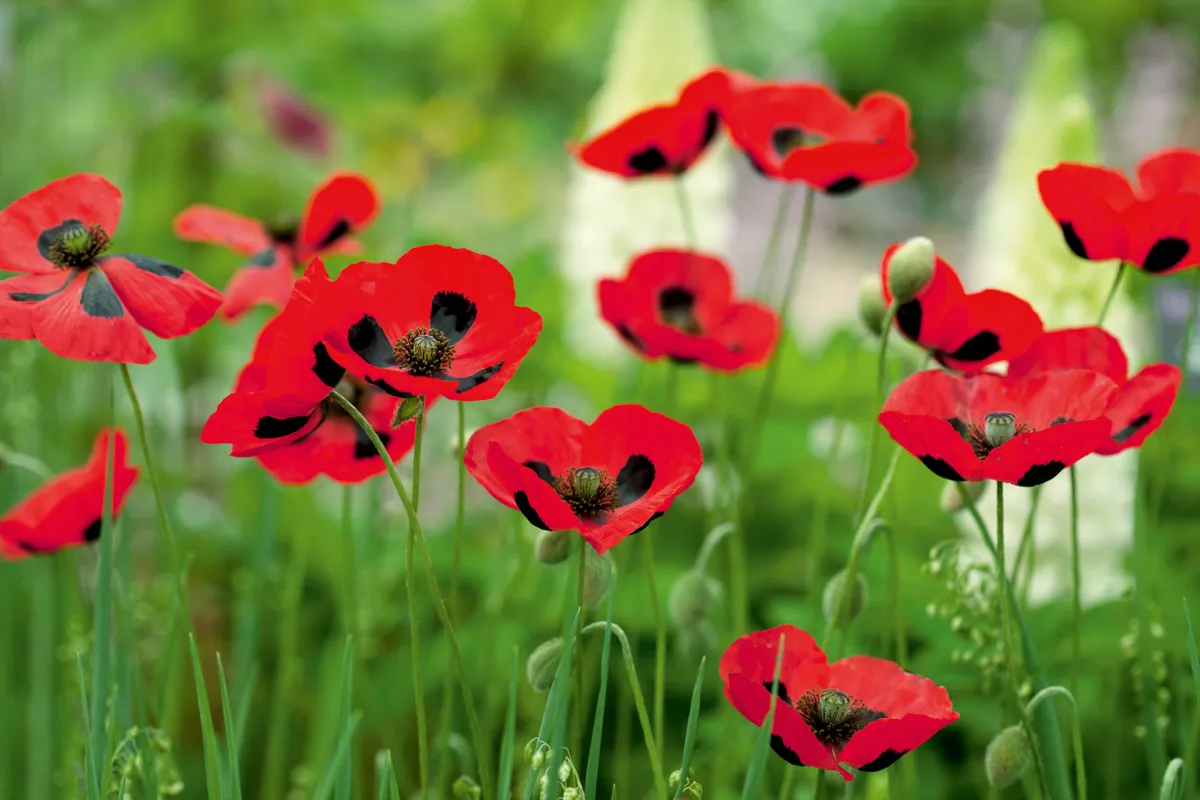Few flowers are as widely recognised as the poppy. In part this is due to its tenacious presence both in rural lanes and fields and on wasteland and roadside verges in towns. Annual poppy seeds are also included in annual meadow seed mixes.
You may also like
- Ten facts you probably didn't know about poppies
- Could Himalayan poppies become extinct?
- Great annuals for your garden
Mainly, though, it is the poppy’s status as an emblem of remembrance that has ensured it is deeply embedded in our psyches. The fragility of the flowers and ephemeral nature of the field poppy make it a perfect symbol of mourning and remembering.

A far less benign influence on humanity is found in another poppy, Papaver somniferum, the source of opium.
Jump to
- Poppies in brief
- How to grow poppies
- Where to grow poppies
- How to grow poppies from seed
- Caring for poppies
- Poppy types explained
- The best poppies to grow
- Where to buy poppies
These two extremes are reflected in the wide range of the genus, They are part of the Papaveraceae family, which includes other genera commonly referred to as poppies, including Meconopsis (the blue poppy) and Eschscholzia (the Californian poppy). Some poppy flowers are elegant and fragile, while others produce flowers that are burly and flamboyant.
Discover 10 facts you probably didn't know about poppies.
Papaver or poppy: everything you need to know
Poppies in brief
- When do poppies flower? Summer flowering.
- How tall can poppies grow? Alpine species grow to just 10cm tall while some Papaver orientale cultivars reach 1.2m tall.
- Where to grow poppies Specific growing conditions vary with the species but in general Papaver need open, sunny situations and well-drained soil.
- Where do poppies come from? Mainly northern hemisphere, including within the Arctic Circle, with a few species found in sub-Saharan Africa.
How to grow Papaver
Where to grow poppies
Annual poppies prefer an open, sunny aspect in well-drained, relatively poor soil but will adapt to any soil that is not waterlogged. They will not grow well in deep shade.
The perennial species tend to be more demanding than the annual ones and although in the wild Papaver orientale grows in poor, rocky soil or in meadows with thin soil, to perform well in the garden it needs rich, well-drained soil. Too much moisture and the crown of the plant will rot; too poor a soil and it will not flower.

How to grow poppies from seed
The annual poppies are among the easiest plants to raise from seed. Most do not like the disturbance caused by transplanting, so are best sown in the spring in the place where you want them to flower.
Overcrowding will produce weedy plants so sow seed thinly and be ruthless in removing seedlings to ensure the plants you are left with have the space to flourish.
All poppies produce copious amounts of seed and most will self-seed around the garden, although it is a bit of a lottery what colour the flowers of named cultivars of Papaver somniferum and of Papaver rhoeas will be.
Caring for poppies
After flowering, the perennial poppies have tatty foliage. The renowned garden designer Gertrude Jekyll advised hiding scruffy poppies with a scrambling plant, such as Lathyrus latifolius, but Papaver orientale can be cut down to the ground. This will encourage fresh, healthy looking leaves as well as the occasional second flowering later in the season.

Papaver types explained
What are poppies? A genus of at least 70 species of annual, biennial and herbaceous plants.
Field poppy, Papaver rhoeas
The common annual field poppy, Papaver rhoeas, is widespread in Europe and north Africa, usually flowering from late May until the end of July. Typically scarlet, in the wild occasional colour variations appear.
Opium poppy, Papaver somniferum

The opium poppy, Papaver somniferum, produce seedlings in a dazzling array of colours and shapes. In the wild the plant is about 1m tall, with glaucous foliage and white or purple flowers. Dozens of cultivars have been bred. Some flowers are fully double (the Paeoniiflorum Group) with a mass of crumpled petals resembling a peony. Others (the Laciniatum Group) have fringed or lacerated petals. A drift of opium poppies is an arresting sight. Papaver somniferum are annuals and self seed readily around the garden.
Oriental poppy, Papaver orientale

The most widely grown perennial poppy is Papaver orientale, whose typically blousy flowers have made it popular in exuberant planting designs. In general, the oriental poppies are taller than other poppies (75cm to 1m tall) with larger and more vibrant flowers.
Icelandic poppy, Papaver nudicaule

Icelandic poppies or Iceland poppies, as their name suggests, are native to subpolar regions of northern Europe and North America. They are shortlived perennials, grown as annuals in the UK.
Icelandic poppies have light green leaves and large bowl-shaped, satiny flowers. The flowers last for many weeks, in shades that include cream, yellow, salmon, orange, pink and red. They make excellent cut flowers and often self seed, coming back year after year.
California poppy, Eschscholzia californica

Californian poppies have funnel-shaped flowers, most commonly in shades of orange but also in pink, red, yellow or white, and feathered, blue-green leaves. Californian poppies are short-lived perennials but are grown as annuals in the UK. They do best in poor, well drained soil, so are ideal for a gravel garden.
Papaver: the best poppies to grow
Papaver orientale ‘Beauty of Livermere’

Shiny, blood-red flowers that are 20cm wide on tall stems make this an outstanding papaver. This poppy is often grown from seed, resulting in paler flowers or shorter plants. Height 1.2m. RHS H7, USDA 3a-7b.
Papaver somniferum

In the wild the opium poppy has variable flowers, ranging from white to deep purple. Garden-sown seedlings can exhibit an even wider range of colours and flower shapes, including, as shown here, double flowers. All have the same glaucous foliage. Height 1m. RHS H5, USDA 1-11.
Papaver somniferum ‘Lauren’s Grape’

A papaver cultivar that comes reliably true from saved seed if no other forms are grown nearby. The single, bowl-shaped flowers are the deepest purple and grow up to 10cm wide. Often a favourite with designers at the RHS Chelsea Flower Show. Height 90cm. RHS H5, USDA 7b-8a.
Papaver rupifragum

A perennial species from southern Spain that has adapted well to northern gardens. Flowers for several weeks in early summer and often self-seeds. Several double-flowered forms available. Height 45cm. RHS H5, USDA 5a-9b.
Papaver rhoeas ‘Bridal Silk’

The common field poppy has always thrown up the occasional white flower but this is a stable seed strain that reliably produces white flowers with the look of crumpled silk. Height 35cm. USDA 1a-11.
Papaver nudicaule ‘Pacino’

A neat dome of grey-green foliage on small flower stems. Disliking winter wet, this papaver grows well in gravel. Some nurseries still sell it under its previous name: Papaver miyabeanum ‘Pacino’. Height 15cm. RHS H7, USDA 6a.
Papaver nudicaule Pulcinella Series

A seed mix noted for producing plants with long-lasting, large flowers in vibrant colours, mainly bright oranges and fiery reds. Single-colour seed packets are occasionally sold. Height 40cm. RHS H7, USDA 2a-8b.
Papaver nudicaule Gartenzwerg Group

© Annaick Guitteny[/caption]
Sometimes known as the Garden Gnome Group, this dwarf strain produces flowers in a range of reds, pinks, yellows, oranges and white. A short-lived perennial, almost always grown as an annual for use as a cut-flower. Height 30cm. AGM. RHS H7, USDA 6a.
Papaver somniferum ‘Cherry Glow’

The deep-scarlet petals have a polished surface, which gives the flower its lustrous quality, further enhanced by the smoky blotches at its base. Height 80cm. RHS H5, USDA 7b-8a.
Papaver commutatum 'Ladybird'

Similar to the common field poppy, Papaver commutatum ‘Ladybird’ has smaller, bowl-shaped flowers that are an intense scarlet. The black blotches at the base of the petals make this an eye-catching plant. Height 40cm. AGM. RHS H5, USDA 1-11.
Where to buy Papaver
Beth Chatto Gardens
Elmstead Market, Colchester,
Essex CO7 7DB.
Tel 01206 822007,
bethchatto.co.uk
Chiltern Seeds
Crowmarsh Battle Barns,
114 Preston Crowmarsh, Wallingford, Oxfordshire OX10 6SL.
Tel 01491 824675,
chilternseeds.co.uk
Cotswold Garden Flowers
Sands Lane, Badsey, Evesham, Worcestershire WR11 7EZ.
Tel 01386 422829,
cgf.net
